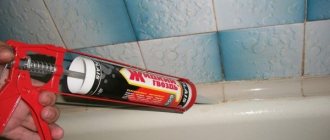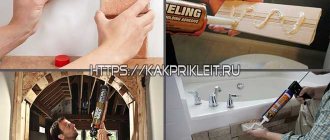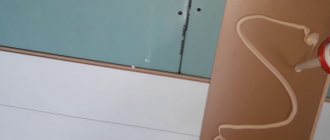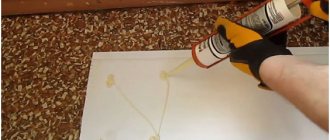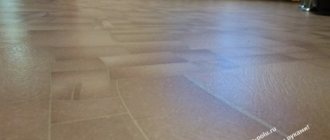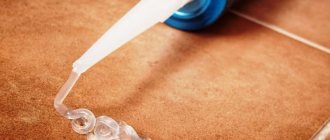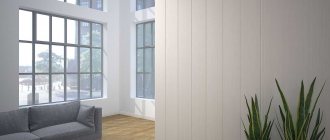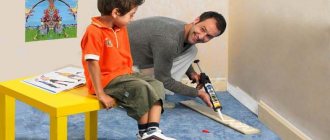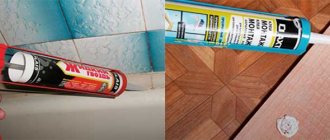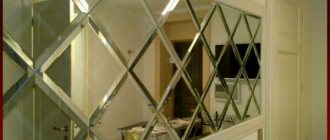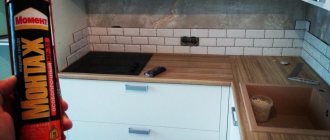Fastening of various building materials is often done using adhesive solutions. For different purposes, a huge number of compositions have been developed, which differ in application method, quality and constituent substances. A universal tool among adhesive options can be called Moment Montazh liquid nails. Even in this line there are many types, in order to choose the right glue, you need to understand the characteristics of the varieties. This will be discussed in detail below.
Liquid nails “Moment Installation” - what is it, properties
Moment liquid nails are distinguished by their ability to reliably fasten various parts together. Usually the color of the solution is white; some types create a transparent layer. Most types of such tools have the following parameters:
- Primary setting occurs after 5-15 minutes;
- Drying time takes a day, complete drying requires one week;
- Frost resistance -30-40 degrees;
- Temperature indicators for storage from +20 to -30 degrees.
The solution is produced in tubes or cartridges with a volume of 125-400 g or ml. The shelf life of the composition varies from 18 to 24 months.
The choice of product should largely be based on the type of Moment Installation adhesive; types are divided according to the type of base composition. It is this feature that is determined by the technical characteristics. The nuances will be described in detail later.
Moment liquid nails are distinguished by their ability to reliably fasten various parts together.
Features and scope of application
It’s not for nothing that this brand of assembly adhesive is called a universal adhesive; its scope is wide; the following use cases can be distinguished:
- Fastening mirrors, shelves, hooks;
- Gluing corners, baseboards, PVC panels, moldings;
- Installation of tiles and flooring materials;
- Gluing various decorative elements;
- Gluing any parts and repairing various items.
The solution can be used for most types of materials - drywall, polymers, wood, cork, glass, metal materials, ceramics. Can be used as a sealant to seal holes between plumbing fixtures, in windows, doors, etc. It is water-resistant, so it is suitable for use in rooms with high humidity levels.
It is water-resistant, so it is suitable for use in rooms with high humidity levels.
How to properly glue tiles to a wall using liquid nails
You can apply liquid nail composition to walls and floors in different ways:
- directly on the wall;
- on the surface of the tile;
- treat both surfaces at the same time.
The latter option is more often used if the tiles are large or heavy. Before you start gluing, decide on the gluing pattern and arrange the rows so that as few elements as possible are used for connection.
Types of glue by composition and technical characteristics
Glue Installation liquid nails can be created from two substances - a synthetic type or a water dispersion polyacrylate. This feature has a strong impact on the area of application; the first option contains solvents that affect the odor and harmfulness of the composition (marked with the letters MR), the second is more environmentally friendly - marked MB.
Glue Installation liquid nails can be created from two substances - a synthetic type or a water dispersion polyacrylate.
Based on synthetic resins
The synthetic base is well suited for installation work; it contains substances that are unsafe for human health, which requires use in rooms with good ventilation. The following technical characteristics can be distinguished:
- High degree of resistance to moisture, which allows use on objects that are constantly in contact with liquids;
- Typically selected as a sealant;
- You can glue structural parts to any base - concrete, brick, glass, wood, metal, PVC and chipboard;
- Copes with gluing sanded and non-porous materials;
- The layer is elastic and resistant to vibration.
Some types of liquid nails with a synthetic base can be used to work on polystyrene foam parts, but this property is rare, so you need to carefully study the instructions.
The synthetic base is well suited for installation work; it contains substances that are unsafe for human health, which requires use in rooms with good ventilation.
Based on polyacrylate-water dispersion
The advantage of this type is that it is water-based, which makes the composition harmless. At the same time, harm to fish is noted, which is the reason for the prohibition of disposal of the product into sewer systems. The properties note the following points:
- Does not emit an unpleasant odor;
- Increased level of adhesion;
- Suitable not only for gluing parts, but also to cover holes to level the base;
- Can be used indoors and outdoors, resistant to water;
- Can be painted over with dispersion types of paints;
- Fast rate of primary drying, time is indicated in the name using a number;
- You can change the location of glued parts within 15 minutes after they are glued;
- It is impossible to freeze the undried layer;
- Used at temperatures of +5-35 degrees;
- When sealed in its original packaging, the solution will be stored for 18 months.
- There are white and colorless types, the second option is marked with the letter P. Suitable for a variety of materials, including PVC.
The advantage of this type is that it is water-based, which makes the composition harmless.
Types and composition
Adhesive “Moment Installation”, depending on the main component in the composition, can be divided into 2 groups:
- The first includes substances with synthetic resins and solvents in their composition, but they are characterized by increased moisture resistance and high strength. The packaging is marked MP.
- The compositions of the second group are made on the basis of an aqueous dispersion of polyacrylate. The chemical composition is neutral, suitable for working with plastic. Adhesives are marked MV.
Advice! To get acquainted with all the information of interest regarding the selected adhesive composition, you can open the technical information sheet. This sheet is presented on the official resource. There you can find information about any Moment Montazh product.
Depending on the markings and abbreviations, the Moment brand mounting adhesive is divided into the following types:
- “Express MV-50” belongs to the category of acrylates, as symbolized by the MV marking. It is used to work with various materials, including wood, plastic, metal, ceramic, plaster and others. Suitable for external and internal gluing. Capable of fastening window sills, baseboards, decorative parts.
- “Super strong MV p-70” also belongs to the subgroup of acrylic adhesives, but does not contain solvents. Suitable for working with various raw materials, even PVC and foam. But it will not be able to glue Teflon, polyethylene, polypropylene surfaces. The additional letter “P” in the marking indicates the transparency of this glue, and the number 70 is the adhesive strength in kg/m². Even large and heavy parts can be held together with glue.
- “Express Decor MV-45” is a white mounting adhesive from the acrylic category, suitable for gluing various decorative parts from different materials.
- “Universal MP-40” is an assembly adhesive that is used for fastening wooden, stone, brick, marble, even glass bases and is washed off very easily.
- “Extra-strong MP-55” is a “Moment” assembly adhesive, which is made from polyvinyl acetate and carbon resins. High-strength adhesive is used for the installation of heavy, metal, wooden, ceramic, and plaster structures. They can even glue PVC, chipboard, and MDF. The description of this glue has a distinctive property - the instant formation of a film on the surface. It will protect the bonded surfaces from dust accumulation. When the materials are bonded to each other, the film breaks down, providing a strong and perfect bond.
Advice! When working with this glue, you must immediately ensure a neat connection of the two surfaces, since movements will only disrupt the strength of the adhesion. The best adhesion is ensured by the initial contact of the bases.
Types of “Moment Montazh” adhesive according to the type of materials being glued
Liquid nails are created in large quantities, for this reason it can be difficult for buyers to choose the right type. One of the selection criteria is the material that is going to be glued.
One of the selection criteria is the material that is going to be glued.
How are they labeled?
To make it easier to choose the composition for the base, the products are divided into separate categories. The following options are available:
- For ceramic and metal bases, you can use all substances from the MP series; Express MV50 is suitable for indoor work;
- MP50 without amalgam in the composition is used for working with mirrors;
- For installation operations in rooms with high humidity, choose MB40, MF80 products, which differ in the properties of the sealant;
- For interior decoration - installation of skirting boards, ceiling parts, styrofoam panels, PVC, MV45 "Express Decor" is used, which has a white tint. And minimal shrinkage, which helps to achieve an unnoticeable fastening;
- For items with heavy weight, select “Super strong Lux”, MP35 “For panels”, “Extra strong” MP55.
For interior decoration - installation of skirting boards, ceiling parts, styrofoam panels, PVC, MV45 "Express Decor" is used, which has a white tint.
Types of glue
Depending on the properties and liquid composition of nails, the following types of adhesives can be found on sale:
- Acrylic. They are based on acrylic in the form of a water emulsion. They are safe, non-toxic and completely odorless. Can be used indoors without harm to humans.
- Neoprene. This type, on the contrary, is unsafe for health, since it is based on polymer components and organic solvents. When using them, do not forget about protective equipment and ventilate the room very carefully. However, their adhesion, compared to acrylic ones, is higher. They are better suited for gluing tiles and other glossy and smooth materials because they do not lose their properties due to changes in temperature and humidity.
How to work with the composition
Apply the composition to a surface that is degreased and free of all contaminants. The glue should be spread from the edge part at a distance of 2 cm; a layer should be applied to uneven bases in a dotted manner. For small objects, linear application is allowed; for better bonding, a snake distribution is done.
For small objects, linear application is allowed; for better bonding, a snake distribution is done.
Application rules
For the acrylic look, the parts are applied and pressed together for a given time. For rubber ones, you will need to press for a moment and separate the parts, which helps to ventilate the thinner. They wait 5-10 minutes, after which they finally secure the items together.
Excess parts of water-based glue are removed with a damp rag; for synthetic ones, the rag will need to be impregnated with a thinner. Or the dried parts are cut off with a sharp instrument.
They wait 5-10 minutes, after which they finally secure the items together.
Drying time
Since there are different compositions, the drying period also differs. Typically, initial setting lasts 25-30 minutes, and complete drying requires one day. You should study the instructions so as not to make a mistake with a specific product.
Typically, initial setting lasts 25-30 minutes, and complete drying requires one day.
Liquid nails Moment Installation are a good option for securing various materials under different operating conditions. A wide range can confuse beginners, but if you study the features of the division of categories described in the article, the choice will be easy.
A little about liquid nails
Not all liquid nails are suitable for ceramic tiles; in the photo you can see 9 adhesive options for various finishing materials. The packaging is the same and the only difference is the inscriptions on them.
| It has already become commonplace that ceramic tiles can be glued to liquid nails mainly for wall purposes. In fact, the glue can also be used for flooring applications. | Liquid nails contain a fine-grained filler, which guarantees gluing of loose parts with a large weight. |
Advantages:
- ease of use;
- absence of construction waste and dust associated with the work;
- Possibility of use on unleveled surfaces;
- withstand heavy weight;
- allows you to adjust the position of the bonded surfaces within 10 minutes after application;
- safe;
- are produced in economical packaging.
Flaws:
- high cost when used on large surfaces;
- relative environmental unsafety of individual species in the first day after application.
| Liquid nails adhesive for ceramic tiles is most often included in the list of adhesives with universal properties | Strength and a high level of adhesion to the surface after the composition dries can be considered both an advantage and a disadvantage. The advantages of this quality are undeniable, since it guarantees that the bonded surfaces will adhere well. However, if for some reason they need to be separated, or the glued object falls off on its own and needs to be returned to its place, then adhesion becomes a bit of a problem. Often even ceramic tiles break when trying to separate them from the adhesive. The separation procedure can be carried out painlessly using special solvents for liquid nails, which are quite expensive. |
Gluing tiles
When working with neoprene compound, take precautions: use a respirator and gloves.
Place the bottle of liquid nails in a special construction gun, carefully cut off the tip and make a test squeeze onto the surface. Next, perform the following steps step by step:
- apply nails to the surface in a zigzag, dotted pattern or make a grid;
- wait 20-30 seconds;
- lean the tile from bottom to top;
- fix for a few minutes (according to the instructions);
- tap large tiles lightly with a rubber hammer to ensure even fixation;
- After installation is complete, allow the glue to dry completely and set properly (about a week), and only then grind the seams.
Use spacer crosses to maintain equal spacing between tiles. Three hours after completion of work, they can be removed.
Advantages and disadvantages
Liquid nails are becoming increasingly popular for bathroom and kitchen renovations. They are excellent for gluing ceramic tiles because they have a number of advantages:
- water resistance - the polymers in the composition are not afraid of moisture, withstand even direct contact with water, and do not deteriorate if liquid gets into the tile joint;
- strength - as it dries, a solid layer of glue is formed, which tightly connects the tile to the base;
- preservation of properties - unlike cement and gypsum mixtures, liquid nails maintain their original qualities throughout the entire period of operation;
- high degree of adhesion - some brands of adhesives can easily withstand weights of up to 80 kg/sq.m. m and even more, so they are able to hold large tiles and porcelain stoneware on the wall;
- resistance to negative factors - adhesives are not afraid of mold, do not rot, do not collapse, and, compared to metal nails, are not at all susceptible to corrosion;
- ease of work - a special gun is used to squeeze out liquid nails, which greatly facilitates the process and makes the application very precise (the installation speed also increases);
- convenience - liquid nails are sold in finished form, they do not need to be kneaded, diluted, or taken out of the container, which reduces the cost of time and effort and eliminates the need to measure proportions;
- cleanliness - the room where you work with liquid nails will always be clean and dry, unlike the place where cement or gypsum mixtures are used.
Liquid nails have few disadvantages, but they do exist. For most compositions, the time for adjustment is quite short, so it is better to lay the tiles straight away or try to quickly level their position. After only 5–10 minutes the glue will set, and it will not be possible to tidy up large masonry without the proper experience.
Liquid nails are much more expensive than cement mixtures. If you want to renovate your entire bathroom, the costs will be significant. Glues of this type are sold in closed cartridges of 300–500 ml, no more, so you will have to overpay for packaging.
Service life: how to extend
Liquid nails are considered a fairly durable material; they can last for several years from the moment of application. To increase service life, you should use the following tips:
- correct the thickness, size, and other parameters of the seam immediately after completion, when the glue has not yet set;
- work at room temperature, since when it drops to +10 degrees or less, the properties of the composition may deteriorate;
- work only with glue that has a normal shelf life, has been stored in suitable conditions, and has not dried out.
Manufacturers and cost
The cost of packaging such a product depends on the brand and country of manufacture and can vary significantly. On average, the price can vary from 80 to 450 rubles. But you can also find more expensive ones.
Let's take a look at the popular fastening products on the market:
- Titebond Multi Purpose. Firmly holds various materials. The hardening period is approximately 20-30 minutes, which makes it possible for a novice master to work with it. Frost-resistant, insensitive to moisture, practically odorless.
- "Moment Installation Universal." The synthetic resins it contains are well suited for brick, metal, concrete and ceramics. Withstands heating up to +70C and cooling down to -40C. The joints are securely fixed.
- LIQUID NAILS LN-901. Neoprene compounds based on artificial rubber are ideal for stone and tile. They are used for facade work because they are durable and can withstand significant impact loads.
- Tytan Ceramics and stone. It is based on odorless and solvent-free acrylic adhesive. Eco-friendly. Fast adhesion after application. Possibility to paint immediately after drying.
Once again, we note strength as the main advantage of the adhesive in question, which allows you to work with many types of tile material. No additional care is required, but they are durable and reliable in operation.
Glue selection
When tiling a bathroom, you should choose an adhesive that can easily withstand high humidity. It is also important to consider the size of the tiles being attached: for porcelain tiles and large elements, it is worth buying liquid nails with enhanced adhesion. If you have to stick elements on concrete or brick, it is better to purchase neoprene-type liquid nails; for drywall, you can use acrylic compounds.
Also, when purchasing, you need to pay attention to the following indicators:
- drying speed;
- suitability for indoor or outdoor use;
- temperature regime;
- fire safety;
- smell.
